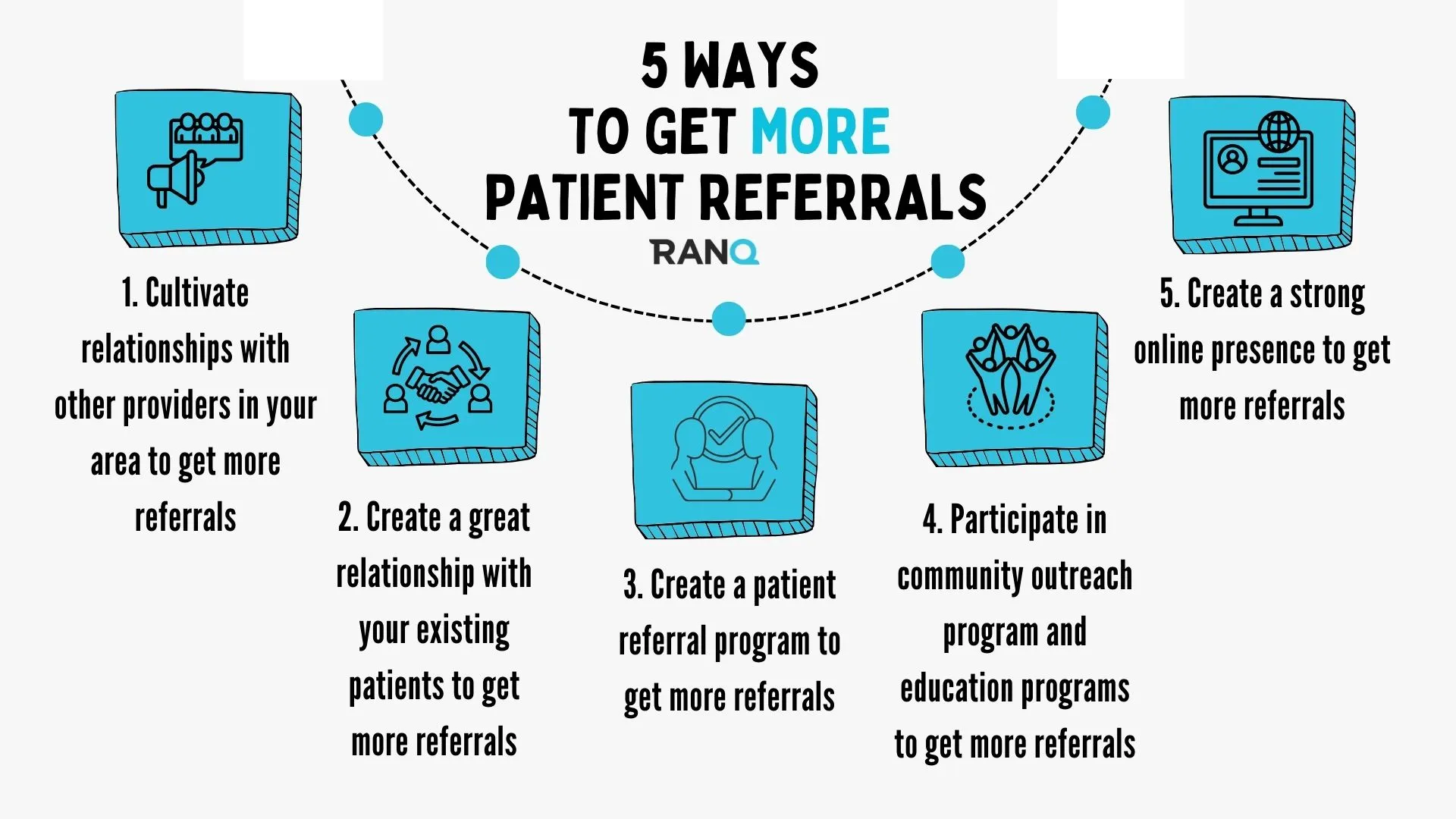As a healthcare provider, you’re always looking for ways to get more patient referrals, but it can be difficult to know how to do this effectively.
The good news is that you have the answer within your grasp! This blog will discuss why patient referrals are essential, methods to achieve more referrals, and how you can generally attract more patients.
Types of patient referrals
Before delving into the specifics of why patient referrals are beneficial, it’s essential to understand their mechanics.
There are four different kinds of patient referrals, and they include:
- Physician-to-Physician Referrals: This type of referral occurs when a doctor refers a patient to another doctor or health provider that’s within their network or even better, someone who they can personally vouch for.
- Patient-to-Patient Referrals: In this type of referral, a patient will actively recommend a doctor or provider to their friends or family members based on a positive experience with that physician or health provider.
- Insurance-Based Referrals: Potentially less merit-based than other kinds of referrals, but this is when a patient chooses a provider based on their participation within an insurance network.
- Online & SEO-Driven Referrals: In this type of referral, a patient finds a physician or health care provider through Google searches, business reviews, and/or online directories.
Why do patient referrals matter?
Beyond the immediate positives of your healthcare provider’s name reaching more prospective patients, patient referrals have more wide-reaching benefits. For one, referrals are an excellent way to build credibility.
Every patient referral adds to the overall legitimacy of your practice. It has been proven that referral-based patients are four times more likely to try a service recommended by a friend than one that is not.
Common challenges in increasing patient referrals
There are a few common problems associated with increasing patient referrals, namely that many healthcare providers don’t offer structured referral programs or their websites are not optimized for visibility. Without a structured referral program, your practice will not have a system to track, retain, or bring in new patients.
When they come to their website, they may find it inaccessible or difficult to use. When designing a patient referral program, the best approach is to institute a multi-channel referral strategy that will increase patient flow through offline and online channels.
5 ways to get more patient referrals

In this next section, we will discuss five actionable ways to bring in more patient referrals.
1. Cultivate relationships with other providers in your area to get more referrals
Some area physicians and providers may be generally knowledgeable about your practice, but one method of increasing patient referrals is to reach out and build individual relationships.
If you’re a specialist, send materials to local primary care physicians that outline conditions that you regularly treat and educate them about your area of expertise. Share data, testimonials, and other information that affirms your credibility as a healthcare provider. This has been proven to encourage repeat interactions and can lead to more referrals.
Keep in touch with these other community providers with regular updates and feedback when referring and receiving providers, and directly thank them if they’re responsible. This back-and-forth builds trust and can streamline the referral process.
2. Create a great relationship with your existing patients to get more referrals
Another method of increasing referrals is by nurturing your relationships with satisfied existing patients. You can directly request loyal patients refer their friends and family to you and even ask if they could post positive reviews and ratings on websites like Yelp.
But before you do this, ensure that you’re providing exceptional care in every aspect of their experience with your practice. That includes everything from ensuring the waiting room is welcoming to quickly making appointments to physician care customized to the patient’s needs.
The patient wants to feel heard and valued, and you should go out of your way to help them understand their treatment and issues like insurance network coverage (and how to find the answers to those questions). This extra effort will help foster patient loyalty and encourage patients to refer others.
Another important aspect of this is integrating patient management software that can streamline check-ins, reduce wait times, and maintain ongoing interactions with the patient. With an automated system, you’ll also be able to easily send out follow-up messages or surveys post-appointment that can lead to more referrals and testimonials.
3. Create a patient referral program to get more referrals
Of course, one of the major aspects of patient referrals is creating a structured system that incentivizes patients and providers to refer others to your practice. This program will simplify the referral process, making it more straightforward and convenient for referral partners and patients. User-friendly referral forms, physician liaisons, and a clear communication channel are all essential elements of a referral system.
When designing the program, make sure it’s user-friendly, readily accessible, and available on the website and in person. Implement a system that tracks referrals, manages appointments, and maintains communication, which will boost efficiency and overall responsiveness. This system could be through email updates, phone calls, or a secure online portal. You should also make sure to train your staff members in how to manage these incoming referrals.
Also, think about incentive possibilities like educational resources or expedited appointment scheduling to encourage patients to sign up. Make sure to coordinate your website, social accounts, and in-office materials to inform patients and providers about the patient program.
4. Participate in community outreach program and education programs to get more referrals
Just as you need to reach out to healthcare providers around you, community outreach and education programs are a great way to increase your patient referrals.
Take the initiative to participate in local medical events or host health workshops where you can offer free seminars on relevant health topics and showcase your expertise. These are all ways to forge relationships with both prospective patients and collaborators.
Before attending these events, plan who to talk to and connect with.
You can also position yourself as a community healthcare leader by writing educational articles for local media, partnering with core parts of the area, such as schools, businesses, and community centers, for health screenings or info sessions, and building personal relationships. These collaborations will expand your reach and network and give you more consistent visibility as a trustworthy healthcare provider.
5. Create a strong online presence to get more referrals
In addition to a patient referral system, it’s important to cultivate a strong online presence. Work to optimize your practice’s website so that you’re easy to find online. A recent survey found that nearly 75 percent of people find physicians through online reviews. You can also directly ask your patients to leave you a positive review. That single review could differ between a prospective patient choosing your office and another option.
You should also work to establish relationships and an identity on social media platforms. This way, patients will have you in mind when they need your services. With your social media profiles, you can share essential updates, offer educational information, and advertise promotions like referral incentives. By doing this, you’ll also appear more often in search results on social media.
You can also reach out to experts who can optimize your SEO. These digital marketing agencies would ensure that your website and personal blogs all feature crucial keywords that list your services and locations. They will also ensure that all of your information, including the practice’s name, physician’s name, address, and phone number all easily accessible and visible.
How to optimize your website to get more patient referrals

A well-optimized website will be one of the main ways to increase patient referrals, as it will increase your ability to reach a larger group of potential patients.
When you bolster your online presence, it will be easier for patients to find you and trust your expertise. With a greater emphasis on content marketing, like email marketing, you’ll have a new way to engage with new patients and strengthen relationships with referral sources.
Ensure your website is mobile-friendly & fast
When optimizing your website, it needs to be both mobile-friendly and fast. If the website is slow to load or hard to navigate, users will not want to use it, and it will reduce possible patient conversions.
Google also favors websites that are optimized for mobile in rankings so that a well-optimized site can attract more possible traffic. You’re missing out on a huge potential patient audience if you don’t maintain your website, as an estimated 7 percent of all searches online are related to healthcare.
Make referral & contact information easy to find
Another primary way to optimize your website is to ensure all referral and contact information is easy to locate. Providers and patients need quick access to contact details and scheduling options. Some possible optimizations include:
- Place your phone number & referral links in the header of the website
- Use clear call-to-action (CTA) buttons (these should be do-able options like “refer a patient” or “schedule an appointment”). Make sure also to include a separate referral form for providers that will streamline the referral process.
- Include an FAQ page answering common referral-related questions
Leverage Content Marketing to Educate & Engage Patients
The best ongoing way to draw patient referrals is by leveraging content marketing on your website to keep your patients on your site with informative, patient-friendly content that builds trust while increasing organic search visibility. By regularly publishing high-quality, optimized content, your website will rank higher in Google searches, bringing organic referrals from search engines. You can easily enlist a company that will provide SEO-optimized healthcare content that ranks on Google.
Here are a few effective content strategies for Patient Referrals:
- Create blog posts that answer common healthcare questions.
- Example: “How to Choose a Specialist for Your Condition”
- Develop patient success stories & testimonials.
- Real patient experiences build trust and credibility.
- Offer downloadable health guides.
- Example: “Managing Diabetes: A Guide for New Patients”
How Ranq Can Help: Ranq provides SEO-optimized healthcare content that ranks on Google, engages patients, and increases referral traffic.
Ready to be swimming in patient referrals? Let us help!
Attracting new patients requires more than a great practice — it requires strategic marketing, strong organization, and a savvy online presence. From targeted digital campaigns to community engagement and incentive programs, success comes from consistent effort.
Or, you can let Ranq handle it. We’ll optimize your website, create compelling blog content, and implement high-impact SEO strategies that help your practice rank higher, reach the right audience, and grow sustainably.
Interested in learning more? Contact us here!

